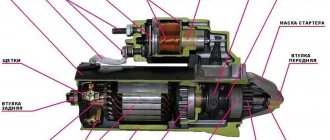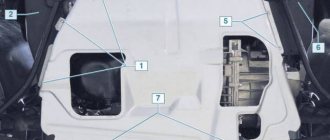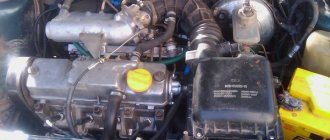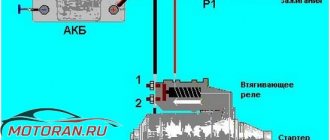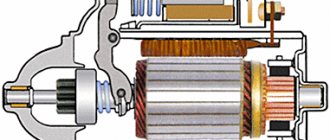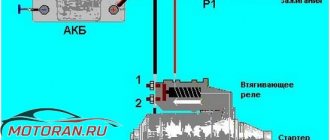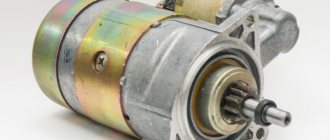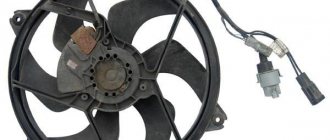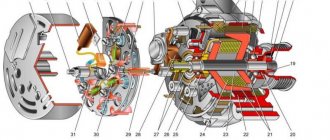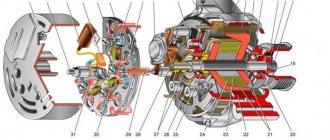If, when turning the key in the ignition switch, the starter simply clicks, but does not turn and, as a result, the engine cannot start, the reason here is quite simple and now we will deal with it in detail.
It's clear that when a car doesn't start right away, it annoys any motorist. The reasons are as follows: the contacts on the battery may simply become disconnected, and there may also be a malfunction in the starter. But an experienced driver, based on certain signs and clicks, will always be able to understand in which particular unit the malfunction occurred.
The starter and retractor relay clicks, what is the reason?
If the starter clicks on a VAZ 2114 and does not turn, then everything immediately becomes clear . These clicks come from the solenoid relay, but this does not mean that you need to change the starter solenoid relay. Current flows to it, which is why it clicks.
If these devices click, then this is not bad, because if there are clicks, then these devices are operational or partially operational.
In most cases, solenoid relays use an electromagnetic method to connect contacts.
When voltage is applied, the contact terminals receive charges with opposite poles, so they begin to attract and when they touch each other, they create a clicking sound.
In order for the engine to start, you need to make sure that these components are in good working order:
- the battery is charged with well-connected terminals;
- The ignition switch and its contacts must be in order;
- the starter relay, the solenoid relay and the starter itself.
Video tip: The starter clicks but does not turn:
Is it possible to repair the solenoid relay?
On older modifications of starters, this was possible. After clicks appear, simply remove the relay and disassemble it.
There is a contact pad inside, usually a plate and two contacts. Oxides can form between them, as well as plastic film from a long start-up. We need to clean this part and performance will be restored.
Watch this helpful video.
HOWEVER. New modifications of the relay are NOT SEPARABLE. They cannot be easily disassembled (without destroying the case) and cleaned. Often a replacement is needed. YES, they break down once every 120 - 150,000 km (and maybe less often) and replacing them is not that expensive.
The relay clicks, but the car does not start, what should I do?
As you understand, if there are clicks, then there is still hope that the car will be able to start. If the starter does not spin, you should definitely pay attention to the contacts of the traction relay. Therefore, the first thing you need to check is the following:
- battery, clean the terminals, perhaps there is simply no contact;
- check if the wires leading from the battery to the starter are in order;
- twitch the key in the ignition switch, perhaps there is a contact somewhere;
- the starter is broken, in this case you will have to remove it and reassemble it, but before that you need to make sure that there is no contact on the brushes;
- If the solenoid relay is broken, then you will just have to replace this unit.
Usually, the starter breaks down quite rarely, and so does the solenoid relay, so most likely it’s all about a discharged battery or missing contacts. If the battery has a weak charge, then it is clear that there will not be enough energy to turn the starter, but it may be enough to operate the charge relay, which is why these clicks are heard.
There are times when the starter takes over the current.
Clicking sounds are heard, but the starter does not turn due to the windings or brush assembly
If the battery, ignition switch, contacts, wiring and starter relay are checked, but it still does not rotate when you turn the ignition key, then the problem is directly in the starter. In such a situation, you will have to completely remove it from the car, disassemble it and evaluate the possibility of repairs. You can also simply replace the starter with a new one.
If you decide to repair the starter yourself, know that the problem with it refusing to rotate under load may be due to:
- Faulty winding, which has a characteristic burnt color and smell;
- A faulty brush assembly, the wear of which is easily determined visually.
Starters are rarely repaired, and such a step should only be taken as a last resort. If it is possible to replace the starter, then it is better to do this than to bother with repairing the winding or brush assembly.
( 408 votes, average: 4.57 out of 5)
Knock in the steering rack: how to remove it, causes, prevention
How to check a car's brake system
Related Posts
How to check the starter
If everything is fine with the battery and the contacts too, then the problem is in the starter. and clicks for this reason . What should I do if the starter clicks but does not turn? To diagnose it and find out where exactly the clicks are coming from, you will have to remove the starter.
You may also be interested in: The best Italian cars: Ferrari, Lamborghini, Maserati and others
Then you need to put this starter on the table, take a charged battery and connect ground to the starter body, and connect the positive terminal to the pin that comes after the relay. If the starter turns, then everything is in order and there are no problems with the retractor relay either. And if the starter clicks, but does not turn as before, this means that there is a malfunction in it and you will have to disassemble it and look for the breakdown inside . The same must be done if the starter idles and does not engage.
What to do if the starter clicks but does not turn
P
Starting an engine is a complex procedure that depends on the proper operation of two components: the car battery and the starter. Directly affects the start of the engine and the presence of switching, that is, the absence of breaks in the wires and burnt-out relays in the engine starting system.
There should be no problems starting the engine in a working car, and if your car starts on the second or third try, this cannot be called the norm. But it is much more unpleasant when the car engine cannot enter the operating cycle at all. A typical malfunction of the engine starting system is clicking noises when turning the key in the ignition switch. The car’s starter does not spin up at this moment; therefore, it will not be possible to start the engine in this case. Let's figure out why the starter clicks but does not spin, and the malfunction of which system components causes such a problem.
Car battery is faulty
The simplest and most common problem that causes the starter to click but not turn when you turn the ignition key is a low battery charge. If the car's power supply is discharged or simply damaged, similar "symptoms" will be observed.
The engine starting system will behave as follows if the required current does not flow to the starter from the battery when the ignition key is turned:
Nothing happens - there are no sounds, clicks or attempts by the starter to spin up. In such a situation, it is necessary to diagnose the health of the battery by turning on any consumer - radio, headlights or others;- The dashboard lights go out and the starter solenoid relay clicks. In such a situation, the battery is almost certainly to blame;
- The starter makes a series of clicking sounds, and the lights on the car's dashboard dim slightly.
In all three cases, be sure to check the battery charge level using a multimeter or load plug. If the battery is faulty or discharged, it should be replaced or charged. When, as a result of the check, it turns out that there are no problems with the battery, it is necessary to move on to the following possible reasons for the appearance of clicks from under the hood when starting the engine.
The starter relay clicks, but it doesn't turn over.
If, when you turn the ignition key, clicks are heard from the starter relay, but the unit itself does not spin, then the problem may be associated with a malfunction of the control cable that powers the relay, or with a problem in the performance of the relay itself.
In such a situation, the car can be started if you short-circuit the “plus” from the battery to the positive control terminal from the ignition switch (the smallest wire of the three is connected to it). If, with such a connection, the starter starts to spin, then the malfunction is definitely not related to the battery, and the problem should be looked for in the relay, ignition switch or wiring.
Solenoid relay diagnostics
If the starter does not turn when the engine starts, but clicks are heard, the first step is to diagnose the relay itself. It connects to the battery and ignition switch via 2 cables. One of them (thick section) comes from the positive terminal of the battery, and the second (thin section) goes from the positive control terminal of the ignition switch. The relay also has a third terminal (thick section), which connects it to the starter motor.
The relay clicks, but the car does not start, how to start the car?
It seems like such a small unit, but it could be the reason why the car won’t start . But if you have a VAZ 2121 or any other VAZ with a manual transmission, then there is an excellent way out of the situation - just take and start the car from the pushrod. To do this, you need to turn the key, as you usually turn it when you want to start the car.
Then find several people and the whole crowd needs to push the car and continue to push it until the speed becomes more or less normal - about 5 km/h or more. At this moment you need to squeeze the clutch, engage 2nd gear and release the clutch, the car will jerk and should start, you need to give the gas at the moment when the car tries to start. If the car stalls, you need to repeat these steps. If it doesn’t stall, then you can drive on without stopping.
And you have to drive carefully so that the car doesn’t stall at a traffic light, and of course, you don’t have to turn off the engine yourself. If there is no one around to ask to push the car, then you need to look for a hill nearby and push the car yourself up to this hill and drive off it. When the car starts to roll down the hill, you can also turn the ignition key and engage second gear and release the clutch.
In general, the car will start this way without a starter and without a battery..
Video advice is a useful way to get out of a situation where the starter clicks but does not turn:
The starter clicks but does not turn: why and how to fix it
Car owners often encounter an unpleasant situation: after turning the key in the ignition, you can hear the starter clicking, but it does not turn. The engine will not start. And the problem, as a rule, is not the battery or the lack of fuel in the gas tank. Without a properly functioning starter, further operation of the vehicle is impossible. There may be several reasons why it makes clicks and does not turn: from simple problems with contacts to serious breakdowns in the starting system. There are also many external signs of a problem.
Why does the starter click but not turn?
Components of a starter using the example of a VAZ 2114
Novice drivers are often mistaken, thinking that the clicking noise is caused by the starter relay. But in fact, the source of the sounds is the retractor device, which engages the Bendix operating gear with the engine flywheel crown and ensures its starting.
Note: the sound produced by the solenoid relay is practically inaudible. The mistake of many novice car enthusiasts is that they blame this particular device. If the relay is faulty, then the car starter will not work.
If you hear several clicks
Experienced drivers can determine by the nature of the clicks exactly where there is a malfunction. If you hear several clicks when you turn the ignition key, you should look for a problem in:
- traction relay that supplies voltage to the starter;
- poor contact between relay and starter;
- insufficient contact of mass;
- other starter contacts that do not fit well together.
The proper operation of the engine starting system depends on the normal functioning of each component. And it doesn’t matter what car you drive: Priora or Kalina, Ford, Nexia or another foreign car. Therefore, you first need to check the electrical connections, starting from the car battery terminals to the starter contacts. This often helps to start the engine, get to the nearest service station and conduct more detailed diagnostics of the starting system.
One click is heard
A powerful click and the engine not starting indicates a problem in the starter. The sound itself indicates that the traction device is working and electric current is flowing to it. But the charge force supplied to the retractor is insufficient to start the engine.
You should try to start the engine several times (2-3) with an interval of 10-20 seconds. If attempts are unsuccessful, then the following reasons are possible:
- the bushings and internal brushes of the starter are heavily worn and must be replaced;
- there is a short circuit or break in the winding inside the unit;
- burnt contacts of the power cable;
- the retractor device has failed and is blocking the start;
- problems with bendix.
Faulty bendix is one of the problems
Bendix teeth may be damaged and prevent the starter from starting properly.
Bendix plays an important role in starting the internal combustion engine (ICE). It is part of the starting system and is located in the starter. If the bendix is deformed, then starting the engine will be difficult. Here are two common Bendix malfunctions: damage to the teeth of the working gear, failure of the drive fork.
The retractor and bendix are connected to each other by a fork. If full retraction does not occur at the moment of switching on, the teeth will not engage the flywheel. In this case, the engine does not start.
When the engine starts the second or third time, you should not put off visiting a car mechanic to service your vehicle. One day you will not be able to start your car, you will have to look for other ways to start the engine.
How to eliminate the causes of problems starting the car engine
Buying a new starter is not always justified. The old unit can serve for a long time. It is enough to carry out qualified diagnostics and replace faulty internal parts: bushings, brushes.
